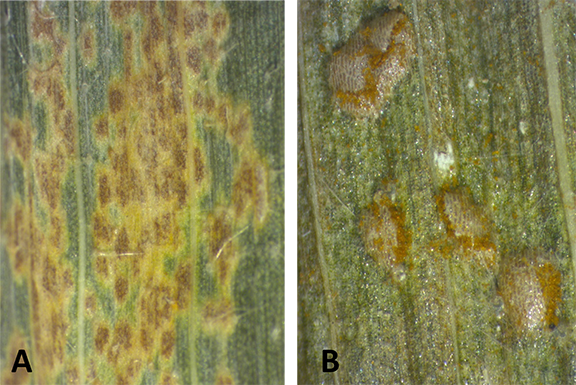Southern rust of corn was officially confirmed this week in both Knox and Jackson counties Indiana. We are documenting the movement of this disease in Indiana, but so far this season we have received only a few samples. Southern rust has is also confirmed on corn in Arkansas, Georgia, Illinois, Kansas, Kentucky, Mississippi, Missouri, Nebraska, Oklahoma, Tennessee, and Texas. If you suspect southern rust please send the samples to the Purdue Plant and Pest Diagnostic Laboratory (PPDL) for confirmation. Spore identification is the only official way we can confirm if southern rust is present. The spores of southern rust have an oval shape verses spores of common rust which are circular (see microscope images below).

Figure 1. A – Common rust spores. B – Southern rust spores from sample taken in Jackson County. (Source: PPDL)
Confirmation of the spores is critical – we have seen samples where it could easily be confused with Physoderma brown spot. Close observation of the leaf with a 10x hand lens or stereoscope is recommended to find the pustules with the spores. See figure 2 below comparing Physoderma brown spots to the southern corn rust pustules on a leaf surface.
Orange spore pustules of Southern rust on corn develop predominantly on the top of the leaf—as opposed to the brownish – red spore pustules of common rust that develop on both upper and lower surfaces of the corn leaf. For more information and images please refer to Purdue publication BP-82 : Common and Southern Corn Rusts https://www.extension.purdue.edu/extmedia/BP/BP-82-W.pdf.
Although the location, color, and shape of the pustules can assist in the identification of the type of rust infection on corn leaves, if you suspect you have Southern rust in your field, submit samples to the Purdue Plant and Pest Diagnostic Lab (PPDL) for accurate microscopic identification. We provide rapid, definitive, confirmation of Southern Rust by microscopic examination of the shape and size of the rust spores. The sample handling fee for a sample is $11.00.
Sample submission forms are available at: www.ppdl.purdue.edu.
Please feel free to contact us if you have questions.

Figure 2. A – Physoderma brown spot are smooth and flat on leaf surface vs. B – southern corn rust pustules rupturing on leaf surface. (Source: PPDL)

Figure 3. iPiPE map of Indiana, Illinois and Kentucky counties where southern rust has been reported, updated August 22, 2018. Red = confirmed county and yellow = suspect county. (Photo Credit: Carl Bradley, ipipe.org)


